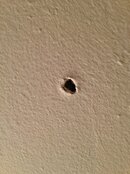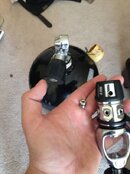You are using an out of date browser. It may not display this or other websites correctly.
You should upgrade or use an alternative browser.
You should upgrade or use an alternative browser.
Need help fixing dumb move (regulators)
- Thread starter trawkins
- Start date
Please register or login
Welcome to ScubaBoard, the world's largest scuba diving community. Registration is not required to read the forums, but we encourage you to join. Joining has its benefits and enables you to participate in the discussions.
Benefits of registering include
- Ability to post and comment on topics and discussions.
- A Free photo gallery to share your dive photos with the world.
- You can make this box go away
kwinter
Contributor
Slowly unscrew the PG hose from the reg......the o ring will extrude with a bit of a pop and will safely depressurize the system.
Do NOT do this. Use one of the LP ports to bleed it off, not the HP side.
Please pardon any typos. Sent from my iPhone using Tapatalk
Chugwhump
Contributor
- Messages
- 1,911
- Reaction score
- 845
- # of dives
- None - Not Certified
Uh oh....
11 minutes and no update.
Prolly dead with a LP port plug bullet to the brain.
Chug
Has made every known mistake and is still inventing new ones.
11 minutes and no update.
Prolly dead with a LP port plug bullet to the brain.
Chug
Has made every known mistake and is still inventing new ones.
Pics of missing fingers?
Bomb defused. You guys rock. I have to admit, that was a very edgy moment. We've all seen youtube videos of pressure vessels suddenly becoming unpressurized. I used my "off" hand to move 1/64 turn per second until the o-ring gave and it hissed at me (very scary moment). plug, ring, and everything is fine. No injuries so far today (aw yeah). I totally thought I was SOL for a while before posting. Thanks guys. I'm another guinea pig that proves that this method is the way to go in this situation.


ps. Hole in the wall is a joke. From running speaker wires.
ps. Hole in the wall is a joke. From running speaker wires.
Attachments
dumpsterDiver
Banned
- Messages
- 9,003
- Reaction score
- 4,662
- # of dives
- 2500 - 4999
Better advice would have been to turn it off:
drink beer,
lots of it,
get drunk,
go to bed,
when you have recovered from the hangover....
the air would have bled out.
check that O-ring,,
drink beer,
lots of it,
get drunk,
go to bed,
when you have recovered from the hangover....
the air would have bled out.
check that O-ring,,
Better advice would have been to turn it off:
drink beer,
lots of it,
get drunk,
go to bed,
when you have recovered from the hangover....
the air would have bled out.
check that O-ring,,
Sometimes that would work, sometimes it may not.
After servicing a regulator, I normally check for leaks by pressurizing it and then closing the valve and leaving it over night. I am OK as long as the pressure doesn't drop more than 50 to 100 psi over night (from a starting point of anything above 1000 psi). It is not uncommon for some regulator to not drop any measurable amount in a 12 to 24 hour period.
I have left a regulator pressured (with the tank valve off) for more than a week with no measurable pressure drop.
---------- Post added January 25th, 2014 at 12:48 PM ----------
I thought of this, but the actual pressure in the reg does most of the work sealing the ports. My main concerns are that I will either strip the plug, or backing it out to the point that the seal is broken will create a very nasty projectile situation in my bedroom.
The IP force is not enough to be a big deal.
A 3/8 plug has a max pressure area of about 0.11 in square. (A= (0.375^2)x (Pi/4)) This is a worst case approximation.
If you multiply that area times the pressure (0.11 sq in x 140 psi) you get a force of about 15.5 pounds.
I do not recommend this, but if you are very careful you could actually totally unscrew the LP plug while it is pressurized. The force is manageable, but you have to keep control of it, or can accelerate with the flow when it totally disengages. If you loose control, it will not pick up a lot of velocity, but there is no need to risk a loose projectile (even a slow speed).
---------- Post added January 25th, 2014 at 12:54 PM ----------
Slowly unscrew the PG hose from the reg......the o ring will extrude with a bit of a pop and will safely depressurize the system.
Bad idea, considering the options.
---------- Post added January 25th, 2014 at 12:56 PM ----------
Make sure the tank valve is off, then slowly back off on the yoke screw. Check the o-ring when you are done.
Not my first choice either.
I have seen it done with a malfunctioning first stage, but it would be my last choice.
I may actually prefer to unscrew the HP port: Less area = less pressure force.
I have to think about which one of this two options would be better. The force is less on the HP plug/ hose, but I like the control of the yoke screw.
The bottom line is that neither one of this is the best choice when you can deal with 140 psi versus 1800 psi.
With 1800 psi, the pressure thrust in the 7/16" port is about 270 pounds (area of around 0.15 in sq).
For the yoke the area can be close to 0.28 in square. This will develop a pressure thrust of as much as 509 pounds.
Last edited:
Chugwhump
Contributor
- Messages
- 1,911
- Reaction score
- 845
- # of dives
- None - Not Certified
Better advice would have been to turn it off:
drink beer,
lots of it,
get drunk,
go to bed,
when you have recovered from the hangover....
the air would have bled out.
check that O-ring,,
I guess you do not like James Bond movies with countdown timers either Dumpster.
Chug
Saving the world one LP port plug at a time.
No smokin' hot "Baccarat Babes" yet though.
Similar threads
- Replies
- 29
- Views
- 2,725
- Replies
- 21
- Views
- 2,800
- Replies
- 39
- Views
- 7,217






